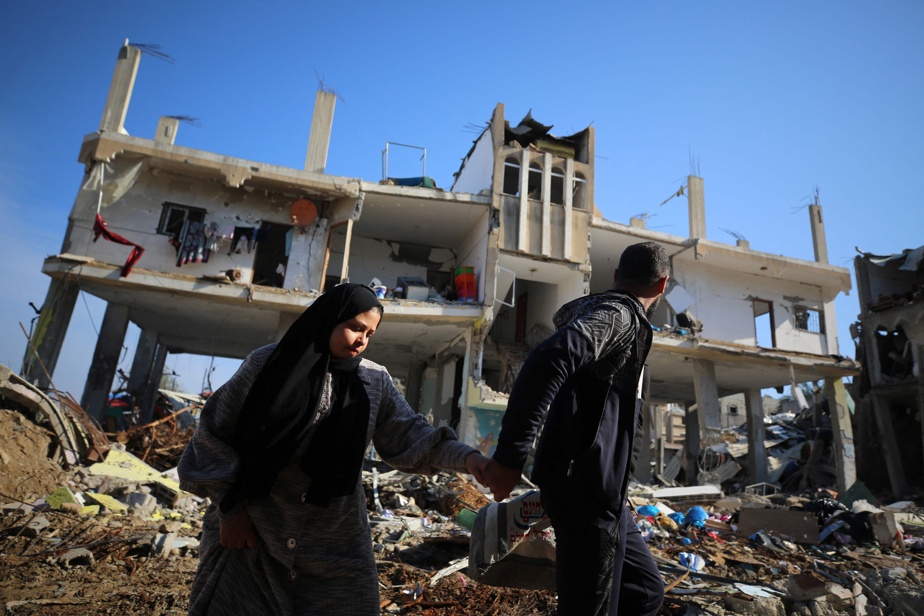Israel is increasing air raids on Wednesday in the south of the Gaza Strip where medicine is expected for hostages held by Hamas and humanitarian aid for the Palestinian population as part of an agreement negotiated by France and Qatar.
During the night, witnesses reported Israeli strikes near the Nasser hospital in Khan Younes, the main town in southern Gaza where, according to Israel, local leaders of the Palestinian Islamist movement Hamas are hiding.
According to these witnesses, these strikes caused panic among the hundreds of people displaced by the fighting who have found refuge in recent weeks in the vast grounds of this hospital. And the Hamas health ministry reported at least 81 deaths overnight in Khan Younes and other areas across Gaza.
Plunged into a humanitarian situation deemed “catastrophic”, Gaza faces a “risk of famine” and a health crisis, in the middle of the peak of winter cold, according to the UN.
“My daughter can’t sleep, she always tells me she’s cold, look how they sleep on the floor, I don’t have anything to cover them, I can’t describe to you how cold it is here. We’re freezing to death outside, how about sleeping here? », breathes Hanine Adouane, displaced by the fighting in Rafah, at the southern tip near Egypt.
All while the territory is experiencing “the longest telecommunications disruption recorded since the start of the conflict, with most residents unable to contact the outside world since January 12,” according to NetBloks, a web monitoring organization.
If attempts to achieve a “ceasefire” or a second truce like that at the end of November have failed, mediation by France and Qatar should allow aid to be delivered to civilians in the coming hours. Palestinians and medicine for the hostages.

PHOTO AGENCE FRANCE-PRESSE
Khan Younes, January 16, 2024
Some 250 people were taken hostage and taken to Gaza during the unprecedented attack by Hamas commandos on October 7 in southern Israel, which killed around 1,140 people on the Israeli side, the vast majority of them civilians killed the same day. according to an AFP count based on official Israeli figures.
In retaliation, Israel promised to “annihilate” this Islamist movement in power in Gaza since 2007, and shelled this territory in operations which killed 24,285 people, or 1% of the population, and the vast majority of women, children and adolescents, according to the Hamas Ministry of Health.
Medicines and help
A truce agreement at the end of November allowed a one-week break in the fighting and the release of around a hundred hostages, reducing, according to the Israeli authorities, the number of people missing to 132, including 27 would, however, have died.
However, at least a third of the hostages suffer from chronic illnesses and require treatment, according to a report published on January 9 by a collective of hostage families, “Bring them home now”.
On Tuesday, Qatar announced an agreement between Israel and Hamas, following joint mediation with France, “on the entry of medicines […] for the hostages in exchange for a shipment of humanitarian aid for civilians in the Gaza Strip.
“The medicines and aid will be sent tomorrow (Wednesday) to the city of Al-Arich” in Egypt “aboard two planes of the Qatari armed forces, with a view to their transfer to the Gaza Strip,” said the head of Qatari diplomacy.

PHOTO IBRAHEEM ABU MUSTAFA, REUTERS
Rafah, January 16, 2024
Israeli Prime Minister Benjamin Netanyahu expressed his “gratitude” to those who contributed to this agreement and insisted that the medicines arrive at their final destinations, his services in Jerusalem indicated.
In Tel Aviv, Israeli anti-war protesters clashed with police on Tuesday evening during a rally against the Netanyahu government and its war in Gaza.
“It’s a vicious cycle of endless violence that leads to nothing. Only a political solution will bring peace, equality and justice to the region,” Michal Sapri, a protester, told AFP on the spot.
“If the occupation continues […]the children growing up today in Gaza are the ones who will face us in a few years,” added Chava Lerman, another protester.
Variable “intensity”
Earlier this week, Israeli Defense Minister Yoav Gallant announced that the “intensive” phase of armed operations in southern Gaza, after those almost completed in the north, “will end soon.”
This war also exacerbates regional tensions between Israel and its allies, primarily the United States, and the “axis of resistance” established by Iran, which notably brings together the Lebanese Islamist movement Hezbollah and the Yemeni Houthi rebels.
On the Israeli-Lebanese border, where exchanges of fire between Hezbollah and Israeli forces are daily, the Israeli army announced on Tuesday new strikes against positions of the movement in southern Lebanon.
The American army carried out new strikes in Yemen on Tuesday, this time on a site from which the Houthi rebels, who threaten international maritime traffic in the Red Sea in “solidarity” with the Palestinians in Gaza, were preparing to launch four missiles.
France has “decided not to join” the strikes of the American-British coalition in Yemen to “avoid any escalation”, President Emmanuel Macron declared on Tuesday, citing “the long-term risk” for Israel to continue operations not sufficiently targeted in Gaza.
The European Union (EU) on Tuesday added to its “terrorist” list Yahya Sinouar, leader of Hamas in the Gaza Strip, who is considered the architect of the October 7 attacks.
And, according to American media, the United States will again designate on Wednesday on its list of “terrorist” entities the Houthi rebels who will join Hamas, also described as such by the EU and Israel.
